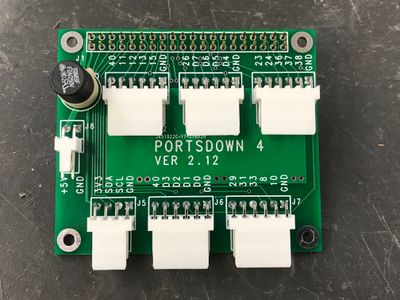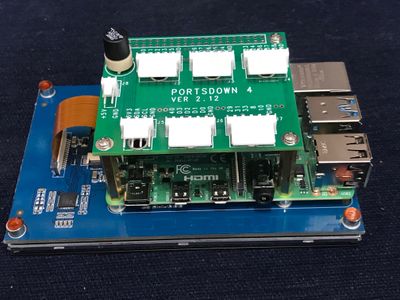Difference between revisions of "GPIO breakout"
(Created page with "===GPIO Extender Card=== In the completed unit, there are 13 signals that need to be routed in or out of the GPIO interface on the RPi. Buying an extender card early in the...") |
|||
| Line 1: | Line 1: | ||
| − | + | ==GPIO Extender Card - version 1== | |
| − | In | + | In Portsdown, there are up to 13 signals that need to be routed in or out of the GPIO interface on the RPi. Buying an extender card early in the project reduces the chance of damage to the RPi and allows these connections to be made safely. The card must break out all 40 pins of the GPIO, and have another connector on top for the LCD display. |
Because of this the Portsdown team have designed a PCB for the job - the blank PCB is available from the BATC shop. ''(If you bought a [[Willow components breakout card|breakout card from Willow]] it can still be used, but we recommend you use this card and put the Willow card in your next project box.)'' | Because of this the Portsdown team have designed a PCB for the job - the blank PCB is available from the BATC shop. ''(If you bought a [[Willow components breakout card|breakout card from Willow]] it can still be used, but we recommend you use this card and put the Willow card in your next project box.)'' | ||
| Line 30: | Line 30: | ||
5 Way [http://uk.farnell.com/webapp/wcs/stores/servlet/ProductDisplay?catalogId=15001&langId=44&urlRequestType=Base&partNumber=2112483&storeId=10151 2112483] | 5 Way [http://uk.farnell.com/webapp/wcs/stores/servlet/ProductDisplay?catalogId=15001&langId=44&urlRequestType=Base&partNumber=2112483&storeId=10151 2112483] | ||
6 Way [http://uk.farnell.com/webapp/wcs/stores/servlet/ProductDisplay?catalogId=15001&langId=44&urlRequestType=Base&partNumber=2396255&storeId=10151 2396255] (only required to connect to a DigiThin modulator - a previous BATC project and not part of the Portsdown project) | 6 Way [http://uk.farnell.com/webapp/wcs/stores/servlet/ProductDisplay?catalogId=15001&langId=44&urlRequestType=Base&partNumber=2396255&storeId=10151 2396255] (only required to connect to a DigiThin modulator - a previous BATC project and not part of the Portsdown project) | ||
| + | |||
| + | ==Portsdown GPIO extender - version 2== | ||
| + | |||
| + | Some changes to the original Portsdown interface were needed with some GPIO changes on the Raspbery PI 4, unused functions were removed and additional ones added. | ||
| + | |||
| + | [[File:Interface V2-12.jpg|400px]] | ||
| + | |||
| + | Parts list here [[:File:Portsdown Interface V2-12 parts.xlsx]]# | ||
| + | Schematic here [[:File:PD 4 INTERFACE V2-12.pdf]] | ||
| + | GPIO list for the Raspberry 4 with Portsdown here https://wiki.batc.org.uk/Portsdown_4_GPIO_Connections | ||
| + | |||
| + | [[File:PD 4 INTERFACE V2-1 SS.png|400px]] | ||
| + | |||
| + | The Raspberry PI 4 runs hotter than the Raspberry pi 3 so consideration must be given to allow more space for air flow. I stand off the PCB to accommodate air flow. | ||
| + | |||
| + | [[File:7 inch P4.jpg|400px]] | ||
| + | |||
| + | [[File:5 inch screen.jpg|400px]] | ||
Revision as of 13:10, 18 October 2021
GPIO Extender Card - version 1
In Portsdown, there are up to 13 signals that need to be routed in or out of the GPIO interface on the RPi. Buying an extender card early in the project reduces the chance of damage to the RPi and allows these connections to be made safely. The card must break out all 40 pins of the GPIO, and have another connector on top for the LCD display.
Because of this the Portsdown team have designed a PCB for the job - the blank PCB is available from the BATC shop. (If you bought a breakout card from Willow it can still be used, but we recommend you use this card and put the Willow card in your next project box.)
The BATC card is very simple to construct with no components other than plugs and sockets.
The circuit is available for download here:
File:PORTSDOWN INTERFACE SCH.pdf.
You can buy the GPIO Extender Card blank PCB from the Portsdown section in the BATC shop - item 6
The "extra tall stacking header" to connect to the Rpi is available from Adafruit - https://www.adafruit.com/product/1979 Or from the Pi hut
The white sockets in the picture above are used to connect to other Portsdown boards and are available from Farnell or you can just hard wire from the pads on the board and pass the wires through the large holes behind the pins.
5 Pin 9731636 http://uk.farnell.com/molex/22-05-7058/header-tht-right-angle-2-54mm/dp/9731636 4 Pin 9731628 http://uk.farnell.com/molex/22-05-7048/connector-header-tht-ra-2-54mm/dp/9731628 3 pin 9731610 http://uk.farnell.com/molex/22-05-7038/connector-header-tht-ra-2-54mm/dp/9731610
Or you can use screw terminal - Farnell part numbers as follows:
3 Way 2396254 4 Way 2396253 5 Way 2112483 6 Way 2396255 (only required to connect to a DigiThin modulator - a previous BATC project and not part of the Portsdown project)
Portsdown GPIO extender - version 2
Some changes to the original Portsdown interface were needed with some GPIO changes on the Raspbery PI 4, unused functions were removed and additional ones added.
Parts list here File:Portsdown Interface V2-12 parts.xlsx# Schematic here File:PD 4 INTERFACE V2-12.pdf
GPIO list for the Raspberry 4 with Portsdown here https://wiki.batc.org.uk/Portsdown_4_GPIO_Connections
The Raspberry PI 4 runs hotter than the Raspberry pi 3 so consideration must be given to allow more space for air flow. I stand off the PCB to accommodate air flow.




